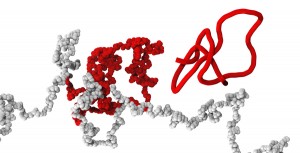It’s all about the knots in Cristian Micheletti’s work on polymers in the June 10, 2013 news item on Nanowerk,
From the news item (Note: A link has been removed),
Nanotechnologies require a detailed knowledge of the molecular state. For instance, it is useful to know when and how a generic polymer, a long chain of polymers (chain of beads), knots. The study of molecular entanglement is an important field of study as the presence of knots affects its physical properties, for instance the resistance to traction. Previous studies had mainly obtained “static” data on the knotting probability of such molecules. In other words, they focused on the likelihood that a polymer may knot. The novelty of the study (“Spontaneous Knotting and Unknotting of Flexible Linear Polymers: Equilibrium and Kinetic Aspects”) carried out by Micheletti and colleagues lies in the fact that this time the dynamic aspect of the phenomenon has been simulated.
Sissa (Scuola Internazionale Superiore di Studi Avanzati in Italy [my very rough translation: International School of Higher Learning and Advanced Studies]), has issued a June 10, 2013 press release which provides some insight into Micheletti’s perspective and more details about the work,
“It’s a little like the difference that lies between a disorganized collection of photographs and a
video. With the former we obtain statistical information (for instance, how many times a knot will appear), but we don’t know how that situation occurred and how it will evolve”, explained Micheletti. “Thanks to dynamic simulation we have found, for instance, that knots tend to form at the ends, where they are very frequent yet ephemeral, that is, they are short lived.”According to the team’s observations, in fact, once formed the knot moves along the chain in an apparently casual manner, it may take a step to the left, then two to the right and so on, so that at the end of the chain it generally tends to disappear,“ falling ” outside the filament. Micheletti also explains that, although more infrequently, it has been observed that the knot moves towards the centre of the polymer: “When this occurs, the knots average lifetime is higher than when they remain trapped at the ends.”
At the center of the polymer also slip knots or pseudo knots, may form. “At first a loop is formed and this blocks another part of the filament. If thermal fluctuations pull to the correct side the knot disappears, while if they pull to the loop side, a proper knot may be created. These knots are very long lived,” explains Rosa [Angelo Rosa, a researcher at SISSA ].
“This research is useful since the data on simple knotting probability reveal nothing about knotting timing”, underlines Tubiana [Luca Tubianam a former SISSA student, now working at the Josef Stefan Institute of Ljubljana]. “If knots form and disappear very quickly, after a certain amount of time we may observe a given percentage of average knotting, yet we do not know whether the knots have remained the same or if they have changed through time. Researchers who carry out experiments of this kind need, instead, more detailed information.”
Micheletti was asked to present this latest work at Harvard University (US) today (June 10, 2013) at an Engineering and Physical Biology Symposium. For the curious who were not able to attend the symposium, here’s a link to and a citation for the team’s research paper,
Spontaneous Knotting and Unknotting of Flexible Linear Polymers: Equilibrium and Kinetic Aspects by L. Tubiana, A. Rosa, F. Fragiacomo, and C. Micheletti. Macromolecules, 2013, 46 (9), pp 3669–3678 DOI: 10.1021/ma4002963 Publication Date (Web): April 15, 2013
Copyright © 2013 American Chemical Society
This paper is behind a paywall.
I have a couple of extra comments. First, there’s a Sissa Medialab which seems to be the school’s science communication initiative. You can go there to see more but you will need Italian language skills if you plan to do much more than look at the pictures. Second, I have referenced macramé (art of knotted textiles) before in a Nov. 10, 2011 posting about a synthetic molecular pentafoil knot

